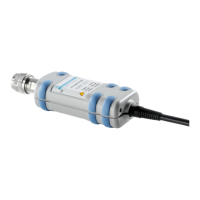R&S NRP-Z11/21/31/41/61/211/221 PC control
1137.7470.12 1.3 E-8
When you insert the CD-ROM supplied with the R&S NRP power sensor, the NRP Toolkit is
automatically installed on your PC. The rest of the procedure is self-explanatory.
The power sensor can be powered in two ways:
Self-powered from a separate power supply via the Active USB Adapter R&S NRP-Z3 or the
Sensor Hub R&S NRP-Z5.
Bus-powered from the PC or a USB hub with its own power supply (self-powered hub) via the
Active USB Adapter R&S NRP-Z3 or via the Passive USB Adapter R&S NRP-Z4.
As the power sensor is a high-power device, there is no guarantee that it can be powered from all types
of laptop or notebook in the bus-powered mode. To be sure, you should determine the current at the
USB connectors beforehand:
In the Windows™ start menu, select Settings – Control Panel
Select the System icon
Select the Hardware tab
By clicking on the button with that name, start the Device Manager
Open USB Controller (all USB controllers, hubs and USB devices are listed here)
Double-click on USB Root Hub or select Properties in the context menu (use the
right-hand mouse button)
Select the Power tab (Fig. 1-1). If the hub is self-powered and the total power
available is, as indicated by Hub Information, 500 mA per port, high-power devices
can be connected.
Fig. 1-1 Displaying the total available power of a USB port
If you have any doubts, ask the manufacturer if the USB port on your laptop or notebook can handle
high-power devices.

